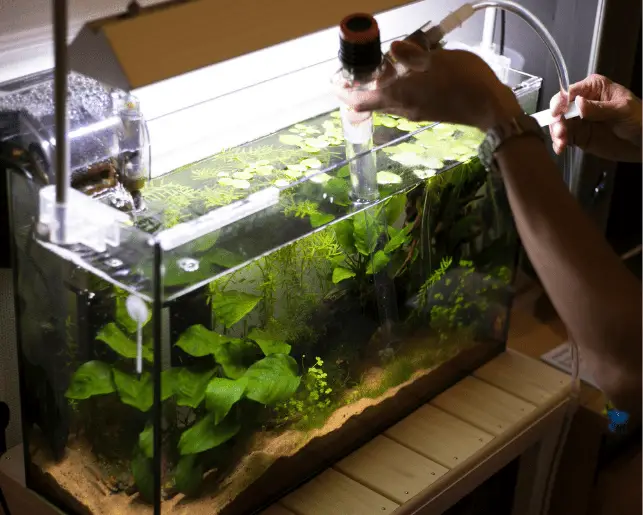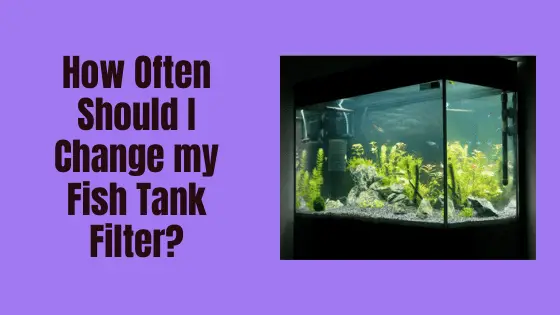A fish tank or an aquarium is a fun addition to any house or place of work. It can be a great way to learn about and teach others about the marvels of fish and other marine life.
Though they’re pretty to look at and can teach us a lot, fish tanks do require some upkeep, and it needs to be done correctly if you want to keep your lovely fish happy and healthy.
You should be cleaning your fish tank filter every three to four weeks. One of the essential pieces of a fish tank is the filter. Since the filter is ridding the water of its impurities, it can get quite dirty.
This article will discuss how long fish tank filters last and provide steps on how to clean fish tank filters. I will also discuss how to change a filter without losing any beneficial bacteria.
Does a Fish Tank Need a Filter?
Most fish tanks require three different filters for the different kinds of filtration. The three types of filtration are biological, mechanical, and chemical.
- Biological Filter. The purpose of the biological filter is to use microorganisms and bacteria to remove the waste that fish secrete. Fish waste contains ammonia, which is toxic to them and must be converted into less toxic particles by other organisms. Generally, a biological filter is needed to support life in a tank, even if you don’t have another kind of filter.
- Mechanical Filters. These filters are used to trap any solid materials floating in the tank’s water. Items like uneaten fish food, dirt, leaves, and decomposing plants are the type of substances that a mechanical filter helps remove. They work by pushing water through a strainer-like filter that will catch the solid materials.
- Chemical Filters. These filters remove other chemicals from the tank, including ammonia, dissolved organic matter, and metals. These filters use chemical resin or carbon to filter out chemicals. Typically, these are used for short-term issues. One example is using a chemical filter to filter out medicine after it is no longer needed.
As a responsible fish owner, you should be aware of these three filter types and able to use them appropriately.
Should a Fish Tank Filter Be on All the Time?
Fish Tank filters should be on all the time because they play such a massive role in the ecosystem of the tank. These filters are necessary for keeping the fish and plants in the tank alive.
Some filters can be loud and disruptive to people’s sleep. Instead of turning the filter off, you should try to identify what is causing the loud noise.
One cause of loud noise in a fish tank is the water level. If it’s too low, it can make a gurgling noise and be fixed by adding more water. This can also help if the filter makes the noise as it should be submerged in the water. The flow rate of the water can also be changed to reduce noise.
Another issue that could be causing your filter to be loud is the build-up of grime. Since the filter is hard at work to keep the life inside your tank alive, dirt and grime can build up if they aren’t cleaned often enough. This can cause the filter to work harder and damage it.
Another issue some people want to avoid is the amount of energy that a fish tank uses to operate. However, the good news is that your filter will not be the component that uses the most energy. In fact, according to an article by Aquariawise, it is only responsible for about 12% of the total power usage.
How Long Does a Fish Tank Filter Last?
Fish tank filters that are well taken care of and made by an industry-trusted brand can last you anywhere from four to eight years. However, a variety of factors can affect the length of time that a filter lasts.
Ultimately, how long a filter lasts will depend on various factors such as:
- tank’s size
- the filter’s brand
- the types of filters you use
- the number of filters you use
- the number of fish living in the tank.
- how well you look after the filter media (the spongy part).
How Do I Clean My Fish Tank Filter?

The process for cleaning your fish tank filter differs depending on the type of filter you’re trying to clean. There are unique steps for cleaning biological, mechanical, and chemical filters.
Mechanical Filter Cleaning.
To clean a mechanical filter, follow these steps:
- Take about two cups of your tank water out of your tank and put it in a bucket or large bowl. This is important because you can’t use plain tap water. The chlorine in the tap water needs to be taken out with a water conditioner.
- Unplug your filter and take it out of the tank. Use your hands to submerge the filter’s sponge into the water bowl or bucket. Scrub the sponge until most of the grime is removed.
- If needed, get some more water from your tank. If your original bowl or bucket is clean enough, use that. Repeat step three with the tubes and casings of the filter.
- Reassemble your filter. Put it back in your tank, and plug it in.
Biological Filter Cleaning.
To clean a biological filter, use the following steps:
- Take about two cups of tank water from your tank and put it in a bowl or bucket. Unplug your filter and remove it from the tank
- Give the filter a rinse in the water. Note: a biological filter needs to have the healthy bacteria on it, so you shouldn’t scrub it aggressively.
- Replace the filter. Place it back in the tank and plug it in.
Chemical Filter Cleaning.
These are the steps for cleaning a chemical filter:
- Take about two cups of tank water and put it in a bowl or bucket. Unplug your filter and remove it from the tank.
- Remove the carbon from the filter. Rinse the filter in the bucket or bowl of tank water
- Replace the carbon with a new one. Replace the filter and plug it back in.
How To Change a Fish Tank Filter Without Losing Bacteria.
It’s essential to be conscious of the bacteria that can build up on your tank’s filter. This bacteria is vital to the health of the tank. You want to preserve some of this good bacteria when you change the filter, so it doesn’t throw off the rest of your tank.
The easiest way to change a fish tank filter without losing bacteria is to use both the new filter media and the old filter media for the first four weeks or so after replacement. Once some good bacteria has built up on the new filter, you can remove the old one altogether.
Another solution is to take the sponge out of the old filter and place it in the tank. This allows the bacteria to keep the ecosystem balanced while not forcing you to run two filters simultaneously.
The final solution is to take the sponge out of the old filter and put it in the new one. Of course, this only works if the new filter and the old one are the same shapes. However, if you tend to stick to one brand and build of filter, this is an easy fix. This will only really work if you have been looking after the sponge by rinsing it on a regular basis to stop it getting completely clogged up.
Conclusion.
Fish tanks are a super fun and aesthetically pleasing addition to any room. However, they do require lots of care to keep them looking clean and lively. The fish and plants in the tank rely on the filters in the tank to keep them alive.
Cleaning the filters and replacing them is an easy process. The two most important things to remember are to use tank water when cleaning your filters and to be sure to keep some of the beneficial bacteria from your old filter in your tank when you replace it.


